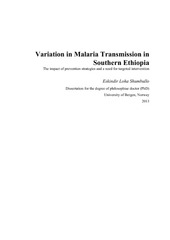| dc.contributor.author | Loha Shumbullo, Eskindir | en_US |
| dc.date.accessioned | 2013-09-19T10:54:48Z | |
| dc.date.available | 2013-09-19T10:54:48Z | |
| dc.date.issued | 2013-09-03 | eng |
| dc.identifier.isbn | 978-82-308-2362-0 | en_US |
| dc.identifier.uri | https://hdl.handle.net/1956/7230 | |
| dc.description.abstract | In Ethiopia, 60 per cent of the population is at risk of malaria. The transmission of the disease is unstable, and hence, the possibility of epidemics demanded continuous vigilance and preparedness of the health system. Meanwhile, the complexity of the transmission of the disease has become an impediment to retain the effectiveness of prevention and control strategies. Understanding factors that play role in disease transmission at different locations, the pattern of disease transmission, the impact of prevention and control strategies and challenges in control efforts were deemed crucial for the way forward. This thesis analysed the local variations in the link between potential determinants of transmission – meteorological factors and malaria incidence. For this, we used datasets from 35 locations found in the Southern Nations and Nationalities People’s Region and registered within the period 1998 to 2007. The findings implied that the variability in the models to be principally attributed to regional differences, and a single model that fits all locations was not found. Although there is a biological link between meteorological factors and malaria transmission, the link is affected by local conditions and non-meteorological factors. With the understanding of a need to incorporate non-meteorological factors, in an attempt to predict disease incidence, a detailed investigation was carried out in Chano Mille Kebele – one of the malarious Kebeles of Arba Minch Zuria district, Gamo Gofa zone, south Ethiopia. A prospective cohort study was conducted for two years with a weekly visit to each of 1,388 households. The findings showed that rainfall increased and indoor residual spraying with Deltamethrin reduced falciparum malaria incidence. Higher disease incidence was observed among males, children 5–14 years old, insecticide-treated net non-users, the poor, and people who lived closer to vector breeding site. Meanwhile, we identified spatio-temporal clusters of high disease rates within a 2.4 sq.km area of the Kebele. Mass distribution of insecticide-treated nets neither showed community-wide benefit nor influenced the spatio-temporal clustering of malaria, though proved to be protective at the individual level. Further analysis on insecticide-treated nets showed that the proportion of insecticide-treated net use reached a maximum of 69 per cent despite a near universal coverage (98.4 per cent) was achieved. Sleeping under the insecticide-treated nets was influenced by gender, age and proximity to the vector breeding site. Factor compromising the usable life of insecticide-treated nets and a lack of convenient space to hang more than one net were reported. The local variations in meteorology-malaria link, the heterogeneous risk carried by different population segments and the observed effect of prevention strategies may help to revisit the approaches towards malaria – for which I forwarded specific recommendations. | en_US |
| dc.language.iso | eng | eng |
| dc.publisher | The University of Bergen | eng |
| dc.relation.haspart | Paper I: Eskindir Loha and Bernt Lindtjørn. Model variations in predicting incidence of Plasmodium falciparum malaria using 1998-2007 morbidity and meteorological data from south Ethiopia. Malaria Journal 2010; 9:166. The article is available at: <a href="http://hdl.handle.net/1956/4678" target="blank">http://hdl.handle.net/1956/4678</a> | en_US |
| dc.relation.haspart | Paper II: Eskindir Loha and Bernt Lindtjørn. Predictors of Plasmodium falciparum malaria incidence in Chano Mille, south Ethiopia: a longitudinal study. The American Journal of Tropical Medicine and Hygiene. 2012; 87(3): 450–459. The article is available at: <a href="http://hdl.handle.net/1956/7214" target="blank">http://hdl.handle.net/1956/7214</a> | en_US |
| dc.relation.haspart | Paper III: Eskindir Loha, Torleif Markussen Lunde and Bernt Lindtjørn. Effect of bed nets and indoor residual spraying on spatio-temporal clustering of malaria in a village in south Ethiopia: a longitudinal study. PLoS ONE. 2012; 7(10): e47354. The article is available at: <a href="http://hdl.handle.net/1956/6507" target="blank">http://hdl.handle.net/1956/6507</a> | en_US |
| dc.relation.haspart | Paper IV: Eskindir Loha, Kebede Tefera and Bernt Lindtjørn. Freely distributed bed nets use among Chano Mille residents, south Ethiopia: a longitudinal study. Malaria Journal 2013; 12:23. The article is available at: <a href="http://hdl.handle.net/1956/7229" target="blank">http://hdl.handle.net/1956/7229</a> | en_US |
| dc.title | Variation in Malaria Transmission in Southern Ethiopia. The impact of prevention strategies and a need for targeted intervention | en_US |
| dc.type | Doctoral thesis | |
| dc.rights.holder | Copyright the author. All rights reserved | |
